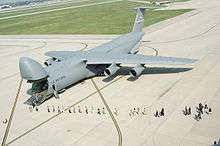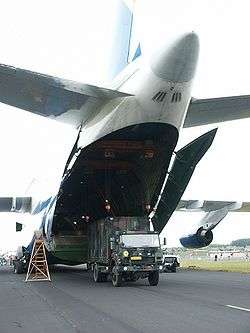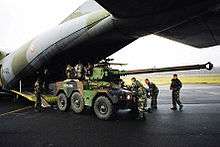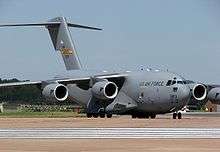Airlift
An airlift is the organized delivery of supplies or personnel primarily via military transport aircraft.


Airlifting consists of two distinct types: strategic and tactical. Typically, strategic airlifting involves moving material long distances (such as across or off the continent or theater), whereas a tactical airlift focuses on deploying resources and material into a specific location with high precision.
Depending on the situation, airlifted supplies can be delivered by a variety of means. When the destination and surrounding airspace is considered secure, the aircraft will land at an appropriate airport or airbase to have its cargo unloaded on the ground. When landing the craft, or distributing the supplies to a certain area from a landing zone by surface transportation is not an option, the cargo aircraft can drop them in mid-flight using parachutes attached to the supply containers in question. When there is a broad area available where the intended receivers have control without fear of the enemy interfering with collection and/or stealing the goods, the planes can maintain a normal flight altitude and simply drop the supplies down and let them parachute to the ground. However, when the area is too small for this method, as with an isolated base, and/or is too dangerous to land in, a Low-altitude parachute-extraction system drop is used.
During disasters and other crises, airlifts are used to support or replace other transport methods to relieve beleaguered civilian populations. Examples include the Berlin Airlift, to supply isolated West Berlin with food and coal, the 1990 Air India airlift to rescue Indian citizens caught up in the Gulf War, and the 1967–70 Biafran airlift during the Nigerian Civil War.
History
In November 1915 the French squadron MF 99 S, equipped with Farman MF.11, flew wounded soldiers from Serbia through Albania to Corfu. This was the first medevac operation in air history.[1][2]
In April 1923 aircraft of the RAF's Iraq Command flew 280 Sikh troops from Kingarban to Kirkuk in the first British air trooping operation. This operation was only conducted over a short range and it was not until 1929 that the RAF conducted a long-range non-combat air evacuation of British diplomatic staff from Afghanistan to India using a Vickers Victoria during the Kabul Airlift.
The world's first long-range combat airlift took place from July to October 1936.[3] German Ju 52 and Italian Air Force Savoia-Marchetti SM.81 were used by the Spanish Nationalists to transport troops from Spanish Morocco to Spain at the beginning of the Spanish Civil War.
Airlifts became practical during World War II as aircraft became large and sophisticated enough to handle large cargo demands. The USAAF's Air Transport Command began the largest and longest-sustained airlift of the war in May 1942, delivering more than half a million net tons of materiel from India to China over the Hump by November 1945.
The largest airlift was the Berlin airlift, lasting from June 1948 to September 1949, an American, British and French operation intended to thwart the blockading of the city of Berlin by the Soviet Union.
The largest civilian airlift ever, the Biafran airlift, was carried out by Protestant and Catholic churches working together under the banner "Joint Church Aid" (JCA) to carry food to Biafra, during the Biafran secession war from Nigeria in 1967–70. This joint effort (which those involved used to call "Jesus Christ Airlines" as an inside joke from the initials JCA) is estimated to have saved more than a million lives in Biafra. Most airplanes departed from the (then) Portuguese colony of Sao Tome and Principe to the bush landing strip of Uli, the only operational "airport" in Biafra, which was made by enlarging a common road. Flights were made flying at night with all lights off and under near-total radio silence to avoid Nigerian MiG aircraft. All the airplanes, crews and logistics were paid, set up and maintained by the joint church groups. JCA and their crews and aircraft (mostly aging multiprop airliners like DC-7's, Lockheed Constellation and Superconstellations, DC-6's, and DC3's) kept flying into Biafra at the cost of many crews lives.[4]
Strategic airlift

Strategic airlift is the use of military transport aircraft to transport materiel, weaponry, or personnel over long distances. Typically, this involves airlifting the required items between two airbases which are not in the same vicinity. This allows commanders to bring items into a combat theater from a point on the other side of the planet, if necessary. Aircraft which perform this role are considered strategic airlifters. This contrasts with tactical airlifters, such as the C-130 Hercules and Transall C-160, which can normally only move supplies within a given theater of operations.
Examples of late 20th/early 21st century large strategic airlifters include:
- Airbus A400M 'Atlas'
- Antonov An-124 'Ruslan'
- Antonov An-225 'Mriya'
- Boeing C-17 Globemaster III
- Ilyushin Il-76 'Candid'
- Lockheed C-141 Starlifter (retired)
- Lockheed C-5 Galaxy
- Xian Y-20 'Kunpeng'
- Shorts Belfast (retired)
With present technology it is impossible to shift a substantial mechanised force, particularly tanks, by air. This difficulty has prompted investment in lighter armoured fighting vehicles (such as the Stryker), as well as some preliminary research into alternative airlift technologies such as ground effect vehicles and airships. Civilian aircraft are also commonly used for transportation. For some civilian airlines, such as Volga-Dnepr Airlines, military contracts account for a large portion of their income.
Tactical airlift

Tactical airlift is a military term for the airborne transportation of supplies and equipment within a theatre of operations (in contrast to strategic airlift). Aircraft which perform this role are referred to as tactical airlifters. These are typically turboprop aircraft, and feature short landing and take-off distances and low-pressure tires allowing operations from small or poorly prepared airstrips. While they lack the speed and range of strategic airlifters (which are typically jet-powered), these capabilities are invaluable within war zones. Larger helicopters such as the CH-47 Chinook and Mil Mi-26 can also be used to airlift men and equipment. Helicopters have the advantage that they do not require a landing strip and that equipment can often be suspended below the aircraft allowing it to be delivered without landing but are fuel inefficient and thus typically have limited range. Hybrid aircraft such as the Bell Boeing V-22 Osprey also exist which attempt to combine VTOL flight with greater range and speed.
Tactical airlift aircraft are designed to be maneuverable, allowing low-altitude flight to avoid detection by radar and for the airdropping of supplies. Most are fitted with defensive aids systems to protect them from attack by surface-to-air missiles.
The earliest Soviet tactical airlift occurred in 1929, in which forty men of the Red Army were airlifted to the town of Garm, Tajikistan (then the Tajik Soviet Socialist Republic) to repel an attacking force of Basmachi rebels under Fuzail Maksum.[5]
Examples of late 20th/early 21st Century large tactical airlifters include:
- Antonov An-12 (turboprop, succeeded by the An-32 family)
- Antonov An-72 (STOL jet family)
- Antonov An-70
- EADS CASA/IPTN CN-235
- EADS CASA C-295
- Alenia C-27 Spartan
- Lockheed Martin C-130J Hercules
- Transall C-160
- Kawasaki C-2
- Shaanxi Y-8
- Shaanxi Y-9
- Embraer Embraer KC-390 (under development)
- United Aircraft Corporation of Russia Ilyushin Il-276 (under development)
Airlifter comparison
Airlifters in service during the late 20th/early 21st Centuries:
| Aircraft | Role | Max. payload (Kg) | Range (NM) | Cruise(Mach) | Ceiling (Ft.) | Price |
|---|---|---|---|---|---|---|
| Antonov An-72[6] | Tactical | 10,000 | 1,728 NM | Mach .68 | 36,089 Ft | $12.5m (est.) |
| C-130J Super Hercules[7] | Tactical | 19,050 | 2,380 NM | Mach .58 | 33,000 Ft | $ 52m (est.) |
| An-12 | Tactical | 20,000 | 1,940 NM | Mach .55 | 33,000 Ft | — |
| Shaanxi Y-8 | Tactical | 20,000 | 3,030 NM | Mach .45 | 34,000 Ft | — |
| Embraer KC-390 | Tactical | 23,600 | 2,924 NM | Mach .70 | 36,000 Ft | $ 50m (est.) |
| Shaanxi Y-9 | Tactical | 25,000 | 3,700 NM | Mach .53 | 34,120 Ft | — |
| Airbus A400M Atlas | Strategic/tactical | 37,000 | 2,450 NM | Mach .72 | 37,000 Ft | € 100m (est.) |
| Kawasaki C-2 | Tactical | 37,600 | 3,000 NM | Mach .80 | 40,000 Ft | $ 120m (est.) |
| Antonov An-70 | Tactical | 47,000 | 1,621 NM | Mach .73 | 40,000 Ft | $ 80m (est.) |
| IL-76MD | Strategic/tactical | 48,000 | 2,380 NM | Mach .70 | 42,700 Ft | — |
| IL-76MD-90A | Strategic/tactical | 60,000 | 2,700 NM | Mach .70 | 42,700 Ft | $ 120m (est.) |
| Xian Y-20 | Strategic | 66,000 | 2,430 NM | Mach .75 | 42,700 Ft | — |
| C-17 Globemaster | Strategic/tactical | 77,520 | 2,380 NM | Mach .77 | 45,000 Ft | $ 225m |
| C-5 Galaxy | Strategic | 122,472 | 2,400 NM | Mach .77 | 34,000 Ft | $ 168m |
| An-124-100M-150 | Strategic | 150,000 | 2,808 NM | Mach .65 | 35,000 Ft | $70–100m |
| An-225 | Strategic | 250,000 | 2,159 NM | Mach .61 | 33,000 Ft | — |
See also
- Airbridge
- Airdrop
- Air cargo
- Berlin airlift
- Loss of Strength Gradient, a military concept
- Operation Nickel Grass, to Israel, 1973
- Power projection
- Sealift
- Hub-spoke distribution
References and notes
- Albin, Denis. "Escadrille 525". L'histoire de l'aviation militaire française (in French). Retrieved 15 August 2017.
- "Veliki rat – Avijacija". Radio Television of Serbia (in Serbian). 8 February 2014. Retrieved 15 August 2017.
- Per photograph caption pg.146 and also text pg.201, Air Power, Budiansky, Stephen, Penguin Group, London England 2005
- Shadows: airlift and airwar in Biafra and Nigeria 1967–1970, by Michael I. Draper (ISBN 1-902109-63-5)
- Tucker, Spencer, 2013. Encyclopedia of Insurgency and Counterinsurgency: A New Era of Modern Warfare: A New Era of Modern Warfare. Santa Barbara: ABC-CLIO. https://www.abc-clio.com/ABC-CLIOCorporate/product.aspx?pc=A3973C
- Pike, John. "C-130J Specifications and Performance". www.globalsecurity.org.
External links
| Wikimedia Commons has media related to Airlift. |
- The short film AIRLIFT ... WORKING FOR HUMANITY (1979) is available for free download at the Internet Archive
